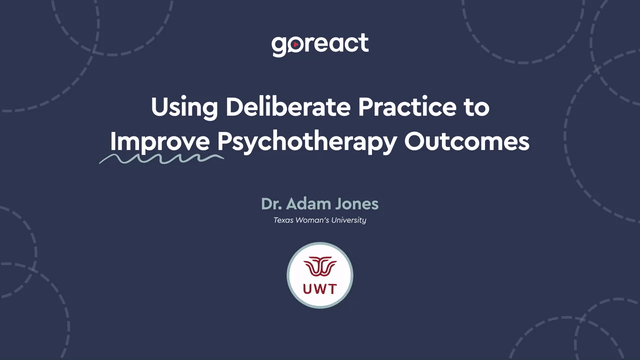Adam Jones:
So there are a couple of steps to this that I think can be helpful in kind of framing what education might look like with deliberate practice. First is establishing a baseline. So when we talk about establishing a baseline with graduate students, we want to look at their outcomes. So outcome monitoring, I know that one came up a little bit, looking at understanding what their facilitative interpersonal skills are. And I actually do have a slide about that in a little bit, but that term facilitative interpersonal skills comes from Tim Anderson’s work. Ben Ogles, who’s on here, was involved in that I know, which really focused on identifying specific skills have been empirically validated as evidence based skills related to client outcomes.
So the facilitative interpersonal skills are a very important way for you to be able to understand what a student’s baseline is in their performance. Targeting and then developing targeted learning objectives. So with targeted learning objectives, it’s important to understand that there are different kinds of practice. So we talk about naive practice, which is this idea of, “Well, if I just do something more and more, then I’ll get better at it.” So just thinking that therapy is practice is kind of naive. It’s actually, kind of like I mentioned earlier, that doesn’t necessarily improve our outcome. So we don’t necessarily get better with experience.
Some of the other practices that we’re seeing a lot come out now about that have a lot to do with purposeful practice, which is I’m going to teach specific skills or maybe a therapeutic concept or a concept from a model, a therapeutic intervention from a specific model and we’re going to practice those skills until I feel comfortable with it. That’s this idea of purposeful practice, which has a big place in graduate education. We need people to really be able to walk before they can run. And so purposeful practice can be helpful in building a therapeutic identity and a sense of comfort in the room, but it’s really only this idea of deliberate practice, which integrates all of those elements I mentioned earlier of feedback, having targeted objectives, and the use of coaches, it’s only through that type of practice that we really see improvement in therapist outcomes. So when we’re talking about deliberate practice, it’s very important to identify what are skills just outside of the therapist’s current ability, what are the things that they can do with a little bit of help? Right?
And I’ll give some examples of that as we go on, but we want to find really that sweet spot where we can challenge therapists to reach just a little bit further. This last step is practice refinement, engaging in a number of activities that can help improve their abilities with those targeted objectives that they’ve identified, and then monitoring those, keeping track of those as we go forward.





